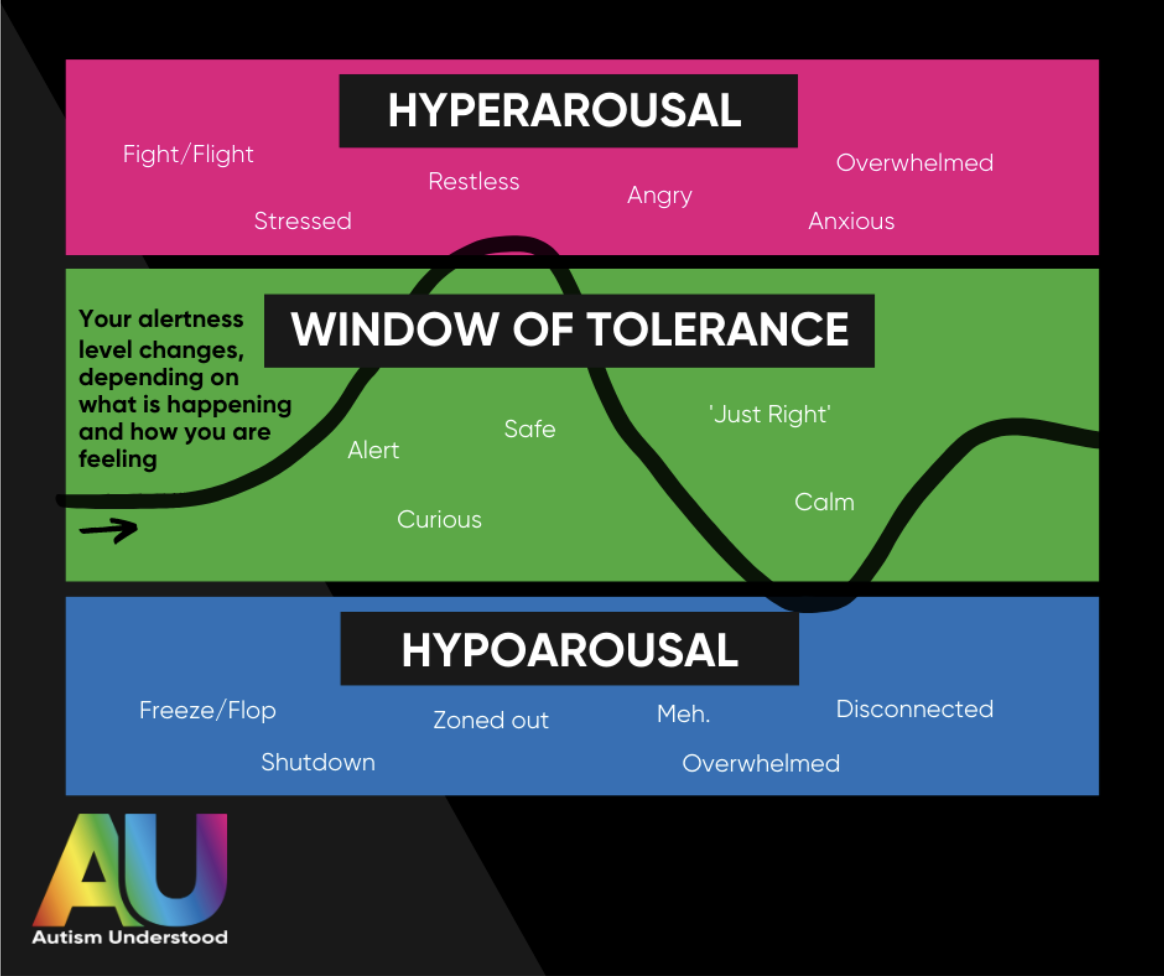Why Transitions in School Environments are Troubling for Neurodivergent Children and Young People
Image: Hamdi Kandi
written by Harriet Clark
In the last blog post on transitions and settling back into school, we gave an overview of why the school environment can be particularly burdensome for neurodivergent children. We offered some practical tips on preparing and supporting your neurodivergent child as they get ready to go back to school.
As the term is now underway, in this blog post we will take more of a deep dive into some of the reasons why mainstream school environments can be hard for neurodivergent young people.
Window of Tolerance
Image: Autism Understood
The Window of Tolerance was a concept first developed by Dr Dan Siegel. The concept is a metaphor to describe what is going on in the nervous system at different times, from calm to stress.
When you are sufficiently balanced and emotionally calm, your parasympathetic nervous system (PSN) is active. The PSN enables you to think and behave in a flexible way. When stimuli become too much, you tip into a hyper-aroused state and the sympathetic nervous system (SNS) activates. This results in anxiety, overwhelm, and a fight-or-flight response.
Neurodivergent children are not able to simply tune out noise or emotionally regulate past the overwhelm of stimuli. Their brains have a harder time than neurotypical children in regulating emotions to bring them back within their window of tolerance.
No One-Size-Fits-All Approach
Accommodations in school should take into consideration each child’s unique learning differences, helping to ensure they stay in their window of tolerance.
Despite accommodations that may be in place, the school environment can still be draining—or worse, overwhelming—when it comes to being able to learn and enjoy school. Too often there is an overriding belief that if neurodivergent children in mainstream schools simply developed greater resilience, they would manage better.
While resilience is a key tool in developing independent life skills, greater understanding and training is needed within education to fully recognise how neurodivergent brains process differently.
The key here is that the school environment needs to honour each individual child’s strengths as well as their difficulties. There is no one-size-fits-all approach when it comes to supporting children managing the multiple daily transitions and changes that occur.
My Emotions in School Inventory (MESI)
A study in the UK asked neurodivergent young people to self-report the elements at school that caused them the highest emotional burden. This study is titled My Emotions in School Inventory (MESI).
Regardless of their specific neurotype, the experiences that caused the most upset and stress in school were as follows:
Last-minute changes to plans
Teachers not understanding them
Chaotic classroom environments
Not being allowed to use preferred coping strategies
Not being able to complete tasks successfully
Bullying and social exclusion
Being treated unfairly by school staff
The emotional burden (EB) levels of school were seen to be higher in neurodivergent young people than in neurotypical students. There is also a link between emotional burden and depression risk.
Schools would do well to directly address these stressors with the aim of reducing them, while also putting interventions in place to support neurodivergent children in developing resilience.
Emotion Regulation
Managing changes and transitions involves developing a complex set of cognitive and emotional skills that take many years to mature. These include:
Resilience
Problem-solving
Adaptability
Emotion regulation
Flexibility
Teamwork and collaboration
These skills all develop in the prefrontal cortex of the brain, sometimes called the “CEO” of the brain. This highly complex part of the brain is still developing until around age 25. The prefrontal cortex is where we make decisions, plan, organise, and regulate our emotions.
Emotion regulation, regardless of neuro-type, is an aspect of development that takes longer to mature in neurodivergent children. Research shows that neurodivergent children often develop executive functions more slowly than neurotypical children.
The Neurobiology of Change
All human beings—neurotypical or neurodivergent—are impacted by sudden changes.
The good news is that humans are wired to adapt. From an evolutionary perspective, our involuntary nervous systems constantly read the environment for cues that signal change. For example, if your body gets too hot, your nervous system increases blood circulation in your skin, making you sweat to cool down.
Our brains are the control centre of the body. They are constantly sending and receiving messages through neurons (nerve cells). One of the key chemicals neurons carry is dopamine. Dopamine is essential for shifting attention and staying motivated.
No Two Brains Are Wired the Same
It’s important to remember that no two brains are exactly the same. For example, some young people with autism are more able to handle change. Not everyone with ASD struggles with transitions.
Every child learns at their own pace. The most important skill is for them to understand their own brains and build resilience over time.
Why Shifting Gear is Hard for Neurodivergent Children
School is full of last-minute changes. Children are expected to adapt quickly, but what helps them to manage?
Dopamine, often called the “feel-good” hormone, plays a major role. Healthy dopamine levels in the brain make it easier to cope with change, stay motivated, and behave flexibly. It also helps us stay safe by tuning in to environmental cues that might signal danger.
Studies show that neurodivergent children have differences in their dopamine pathways. Their pathways are less available, meaning it’s harder for their brains to receive enough dopamine. Lower levels can make them more reactive or distressed when facing unforeseen change. Low dopamine can also cause a scattered emotional state, making positive choices harder.
This is why a child may “melt down” when asked to shift attention. They are not being intentionally difficult—they are still developing self-regulation skills. Because transitions may trigger uncomfortable feelings, they need extra support with regulation.
On the flip side, children and young people with ADHD can hyper-focus when sufficiently stimulated and experiencing enough dopamine. They may be able to focus for hours on activities they enjoy, such as computer games.
Medication such as Ritalin works by increasing dopamine levels, improving communication between brain cells.
Dopamine can also be increased naturally through activities children enjoy, such as listening to music, exercising, practicing mindfulness, and eating a healthy, regular diet.
Final Thoughts
Changes to routines can be hard—remember to give your child lots of empathy.
Celebrate your child’s wins, their strengths, and their problem-solving abilities, while also supporting them through the challenges of change.
When your child feels safe and supported by you and their teachers, change won’t feel so intimidating.
In our next blog we are continuing to explore transitions… and I am excited to announce that I am going to be sharing an interview with an industry expert, a psychologist who will share her practical top tips and strategies in managing transitions.
If you are looking for specialist, bespoke tutoring, don’t hesitate to call Bright Teach today!
Tel: 01273 033 243
Email: info@brightteach.com


